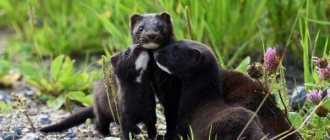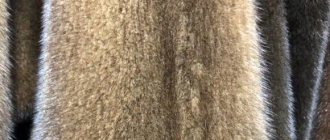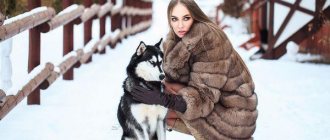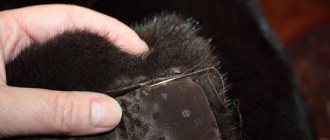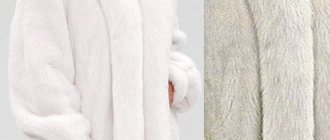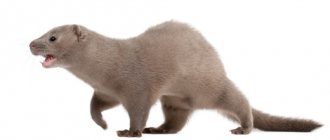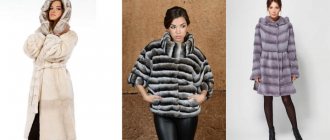Both mink and sable are valuable fur-bearing animals; they are often bred in artificially created conditions. Despite many similarities, the animals are different. Let's look at the difference between mink and sable.
Interesting. These species can mate with each other, but do not interbreed, which means they cannot have offspring. This is justified by the difference in karyotype.
European mink
Features of the animal:
- This is a small animal with a body length of 30-45 cm.
- Body weight is relatively small, only up to one kilogram.
- This is a swimming animal, with clearly defined membranes on its paws for swimming.
- This is a predatory mammal with a relatively short tail, only 15-20 cm.
- The fur is quite dense and thick, short. Even after being in water for a long time, the fur prevents the body from getting wet.
Important. This species is listed in the Red Book as an endangered species.
conclusions
All of the above-mentioned species belong to the mustelid family and initially have largely overlapping habitats. Previously mined industrially for their fur, they are now mainly bred on animal farms (the American mink has been introduced almost throughout the world).
- The sable in the mentioned trinity will be much larger, both types of mink are smaller.
- American/European minks in nature lead a semi-aquatic lifestyle with an appropriate diet (fish, frogs, etc.) - which is why they have clearly defined interdigital membranes on their paws.
- The sable quickly climbs trees (up to the crown inclusive), is omnivorous, and prefers to build its nests in hollows.
- From a distance, it is quite simple to visually distinguish a sable from both minks: it does not have well-defined white spots on its face/chest.
- Exclusivity . In this parameter, sable has no equal. It is an indicator of wealth, status and refined taste. If mink can be seen on every fourth or fifth lady, then we don’t see sable every day.
- Price . It directly depends on the exclusivity and rarity of the fur. Compared to mink, the cost of a sable fur coat is at least 3-4 times higher.
- Wear resistance . Despite the fact that mink is also considered a practical fur, it is much inferior to sable. If you are lucky enough to find a really high-quality fur coat, it will not lose its appearance and properties even after several decades!
- Sable skins are the lightest . Even massive-looking fur coats will be very easy to wear. But fur is much warmer and better adapted to moisture. The quality of mink in this parameter is also high, but it cannot reach the level of sable.
From a utilitarian point of view of the differences between fur (skins), you need to keep in mind that current dyes easily make it possible to obtain absolutely any color/shade (and there are all sorts of “plucked/shorn minks”!) - therefore, for already dressed skins (without paws, etc.) d.) to differentiate sable from mink fur, you should rather look at the texture of the fur than at its color: mink fur is shorter and has a dense undercoat. And since minks prefer a semi-aquatic lifestyle, their fur is more difficult to get wet by pouring water on it.
Animals Beauty and fashionComment
American or eastern mink
Features of the animal:
- The body length can reach half a meter.
- Body weight up to two kilograms.
- Ponytail length up to 25 cm.
- The swimming membrane is somewhat less developed than in the European breed.
- The general structure of the fur is similar to that of European mink, but the color may differ slightly.
These two types of animals are slightly different from each other, but in appearance they are very similar.
How to choose a sable fur coat
This type of material for sewing a fur coat is expensive, because even the cheapest sable is still much more expensive than mink. If the price of the first type of fur is high for you, then you can reduce the cost of the product by reducing the volume of the fur coat and its length. Also, a good option for saving would be to reduce the consumption of the fur part by increasing the volume of trimming; the created picture can be presented in the form of a creative designer’s decision. But remember, you shouldn’t save too much on a lower grade of sable and a lower quality of tailoring, since this will be very noticeable to the eyes of other people, which can spoil your reputation as an exquisite lady.
Fur difference
Know that this type of fur can be different, therefore:
- It is important to purchase it together with a specialist or, in extreme cases, from consultants. The latter may well be able to clearly demonstrate and reliably compare the quality characteristics of the material with concepts that will differ from the unprofessional “Oh, look how this fur shimmers perfectly in the sun”;
- To begin with, be sure to visit a salon that specializes in expensive types of sable fur and pay attention to what is well appreciated, touch the high-grade fur part, feel the delicate silkiness and rich density of the material.
- Be careful, the market shows quite a lot of fur coats and sheepskin coats made of simple, cheaper varieties of sable, as well as painted marten; they are often sold as “sable”. If you see real sable fur at least once, then it will be extremely difficult to mislead you when examining any varieties.
Dangerous drawback of a sable fur coat
The simplest dressing is often carried out in places located closer to the place where the skins are extracted. Most often, such materials have a clearly noticeable “animal” aroma and a not perfectly polished interior. Due to the increased amount of residual fat, the processes of aging and loss of strength of the flesh of these skins occurs much faster.
Brand level
Often the grade of sable fur in a fur coat and its total price significantly depend on the different brand level of the product. With a better version of the initial materials, the cost increases significantly, but only high-level manufacturing companies, with a previously noticeable and therefore considerable price range and clients from a high price audience, can allow this procedure to be carried out. In some types of collections of an unpromoted brand, it is literally impossible to find elite sable fur.
If you want to buy a sable fur coat of an elegant, chic level - darkish with a considerable amount of chic gray hair, be prepared for the fact that these stages are not lightning fast - a valuable product of this class must still be “caught”:
- Complete an order;
- Arrange to be notified of new arrivals;
- Arrive in a timely manner and make a decision, since “bargaining is not appropriate.”
Sewing level
Sable is all varied: it is literally impossible to find two absolutely identical skins. In addition to the color shade, the tone of the underfur itself, its length, as well as the density of the villi, also have an important influence. The main task and feature of a skilled furrier is to arrange the skins in a certain position so that no irregularities are too noticeable in appearance, but this is an exorbitantly high class level of work; such specialist craftsmen are the real elite in the fur industry.
Be aware, traditional row creations are very painstaking in execution, in which the skins of the animal should harmoniously create a single whole in terms of color shade and length of the canvas. When you see in the finished product a certain “rattling” of parts of the material in color, density or height - this is low-class work of the furrier and incorrectly selected sable fur in general. The now widely known transverse arrangement does not have these high demands on the quality of the selection itself.
Fur material consumption
Sable fur coats have a clearly defined topography:
| Skin | the skin has a low neck with a spot on the neck, turning into a clearly noticeable cross; |
| Back | there is a chic fluffy back with a smooth dip in the dark ridge; |
| Pile | there is a delicate, sparse, but high pile on the belly; |
| Fur | The short fur on the sable's legs is clearly noticeable. |
If changes in the height of the fur are very noticeable to the eye, there is no refined evenness, and there is a feeling of clumsiness, then it is more likely that the entire volume of the surface of the skin is involved, along with low-value, differently pubescent areas. In high-class fur creations, only the back is used, which is located no lower than the cross.
Sable
Description of the animal:
- The size of the sable is larger than that of the mink, this is a clearly noticeable difference. Body length can reach 60 cm.
- Tail length about 20 cm
- The animal has a characteristic terrestrial lifestyle, but if necessary, it can climb trees and can immediately set up nests in hollows.
- The coat color is dark, but uneven. The color of the fur on the chest is lighter.
- The sable coat is so attractive that it is highly valued by people.
The differences between these animals can also be seen in the photo. They are bred for fur and are also often kept as pets.
Similarity of fur
Both types of fur are characterized by silkiness, softness and a very attractive appearance. The latter, of course, largely depends on the workmanship and quality of tailoring. However, in general, both mink and sable captivate women with their luxurious fur texture.
Short fur coat made of sable
Mink coat
The second important criterion when purchasing such an expensive product as a fur coat is durability. And in terms of this parameter, the 2 types of fur are again on par: according to experts, the estimated service life of mink and sable coats is 10 seasons.
The third property that both types of fur have is lightness and, due to this, ease of wearing.
What are the differences?
The above species belong to the mustelidae family. Previously, they were bred mainly for the sake of obtaining high-quality fur, but now they are bred on animal farms. The main differences are as follows:
- Sable is larger than mink.
- Minks preferably lead a semi-aquatic lifestyle and have an appropriate diet, but sable prefers a terrestrial lifestyle, with an appropriate diet.
- From a distance it is easy to understand who is who. The sable does not have well-defined white spots on its face and chest.
- The cost of a sable coat is almost 3-4 times more than a mink coat.
Reference. Fur coats made from sable fur are much more valuable, because they are light, wear-resistant, and beautiful.
Whose fur is more expensive: mink or sable?
Sable fur is worth its weight in gold and is considered the most expensive. In ancient times it was used only in royal decoration. Fur is distinguished by its lightness, softness and beautiful shine. At the same time, it is incredibly durable and can last for many years without losing its appearance or other characteristics.
For fur coats and other things, the skins of animals caught in their natural habitat are used, which explains their high cost. The most expensive fur in the world is the Barguzin sable, which lives in the Baikal region. It is distinguished by a rich dark color with a grayish tint. The cost of one skin is one and a half to two thousand dollars.
Which fur coat is more expensive: sable or mink?
A mink coat is traditionally considered a symbol of wealth and high status. Nowadays, the skins of animals raised on fur farms are used for clothing. There are quite a lot of varieties of American and Scandinavian mink; the color palette of fur is striking in its diversity. The well-known “black diamond” is especially valued.
Depending on the quality of workmanship, color and style, the cost of a fur coat can vary from one to fifteen thousand dollars.
Designers love sable fur for its unique beauty, so they use it to create collections in its natural form, without dyeing or other processing. Even a small fur coat will cost from 50 thousand dollars, and for a luxurious coat you will have to pay about 250 thousand dollars.
What is the difference between mink and sable and their fur?
In any situation, we are talking about not very large mammals of the mustelid family, which for convenience it makes sense to divide into three different groups: European mink (Mustela lutreola), American mink (formerly Mustela vison, now Neovison vison) and Sable (Martes zibellina ).
All representatives are considered valuable fur-bearing animals and in many cases are artificially bred en masse (they are also subject to additional hybridization with other representatives of the mustelid family). Such variants can mate with each other, but do not interbreed - in other words, they do not produce offspring due to differences in the karyotype (the number of chromosomes), although even in nature crossing with other representatives of the extensive mustelidae family is possible - for example, in the Urals you can sometimes find a marten hybrid and sable - kidus, or a hybrid of the European mink and a simple ferret - honorik (at one time this hybrid, due to its significantly larger size compared to the parent European mink, was artificially bred on animal farms).
Models with sable hood
It is important to note that the sable finish is not only luxurious, but also durable. Perhaps the most practical and beautiful is the model with a hood made from the skin of this animal. This hood is very light and does not fall back. Fashionistas who want to maintain their hairstyle need not worry: the hairstyle will remain at its best. A sable hood will protect you from bad weather and keep you warm.
To sew such hoods, fur with long pile is used, which frames the beauty’s face favorably. They try to match the color of the hood to the tone of the mink coat or create a harmonious contrast.
As for hood models, there are those made entirely of sable, and there are options only with a sable lapel. The hoods that extend into the collar are particularly luxurious.
Comparison
Although in some ways the two materials under consideration for sewing fur coats are similar, the differences between sable and mink are more significant and numerous. The main one is price, and this parameter very often becomes decisive in the selection.
MINKS: how a beast appeared in our house.
Sable fur coats are many times more expensive than mink coats of the same style. In addition, precisely because of the high price, sable fur is especially widely used not for sewing the entire product, but exclusively in the form of decoration: sleeve edges, hem, hood, collar trim, etc.
Mink is more popular among both manufacturers and visitors. The price range for a fur coat made entirely of this material can vary from affordable and affordable to comparable to short fur coats made from sable.
There are many options for mink and options for processing it, and this determines the price range. In terms of quality properties, sable fur is definitely among the leaders.
It is warmer and more resistant to moisture.
The first superiority will be appreciated by residents of northern latitudes, the second is very important in regions where there is often snow and rain.
How to distinguish sheared mink from other fur
Initially, what you need to pay attention to when choosing a mink is the weight of the product. Mink is much lighter than any other fur. Very often, manufacturers camouflage themselves with the fur of a rabbit, beaver, ferret or marmot. Therefore, it is so important to know their main differences in order to avoid counterfeiting.
- The marmot is often passed off as a mink. But it is distinguished by its prickly fur and hairs, which are of different lengths. The marmot's spine is elastic, but plastic, so it does not return to its original shape. When used, the fur turns blue.
- Rabbit fur is softer than mink and has a non-uniform color. When you pinch the undercoat, lint remains.
- The ferret has a high awn and sparse undercoat. Also, the color of the ferret's fur is peculiar (light below and dark above).
- The beaver has tough fur and thick flesh.
When choosing mink fur, you should not rush; now you know simple methods; you should use all your senses to find the right model. After all, in order to make a profitable purchase, you need to be attentive to the details.
It might be useful to read:
- When can you cut your hair according to the oracle;
- Happy Easter greetings in verse;
- Military pension in the year latest decisions;
- How to properly celebrate the New Year of the Rooster: signs and customs;
- Holiday when snakes go to bed;
- When does Alexey celebrate Angel Day? ;
- The youngest mothers in the world (with photos) Let them say the issue of dad who;
- Happy New Year to colleagues;
